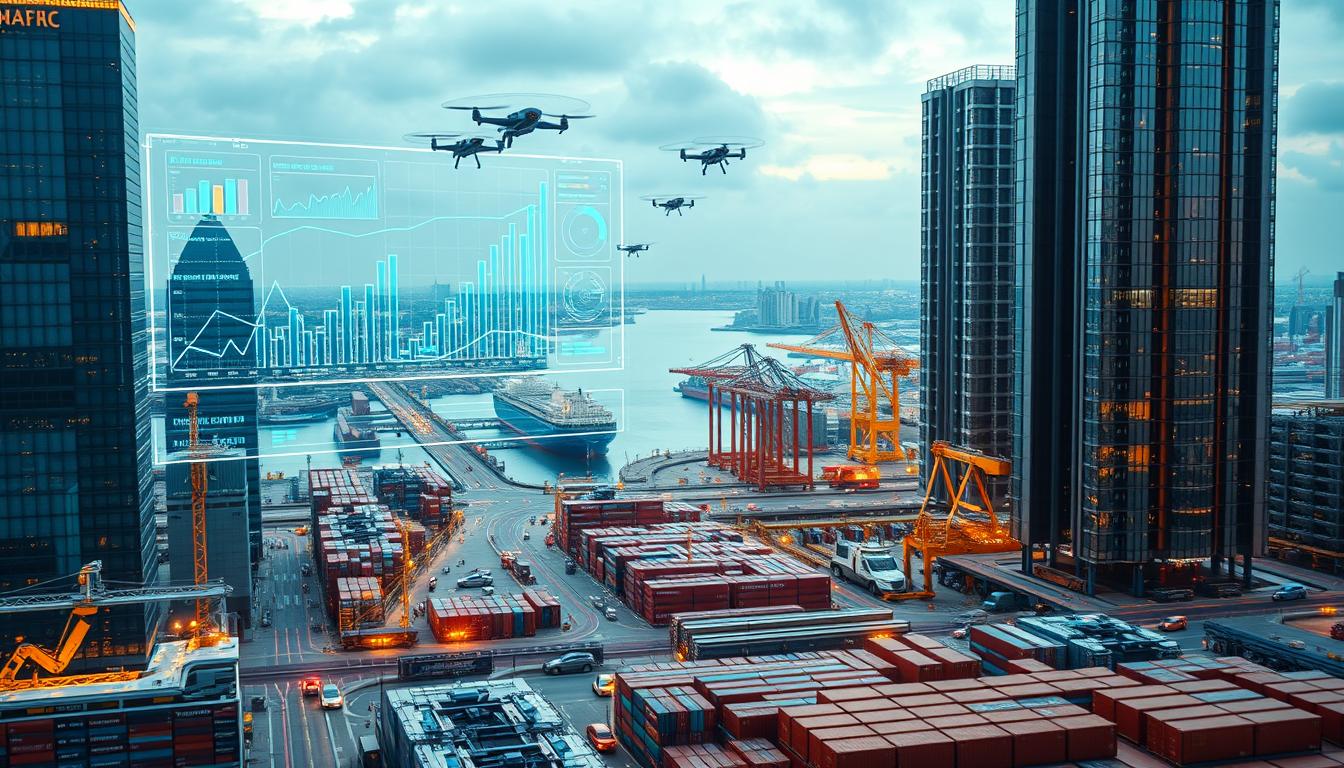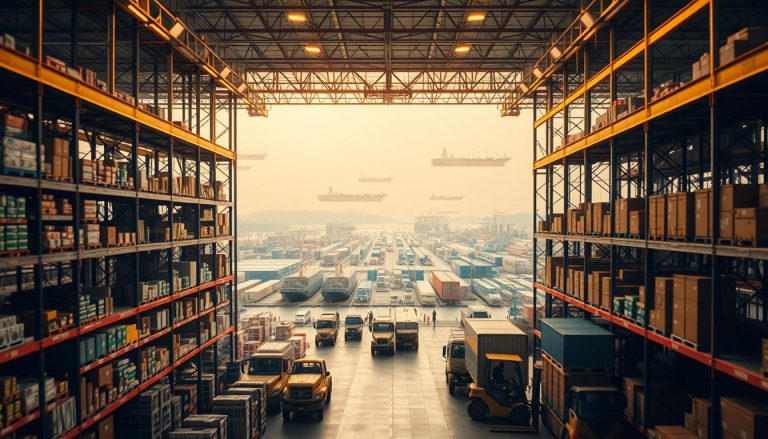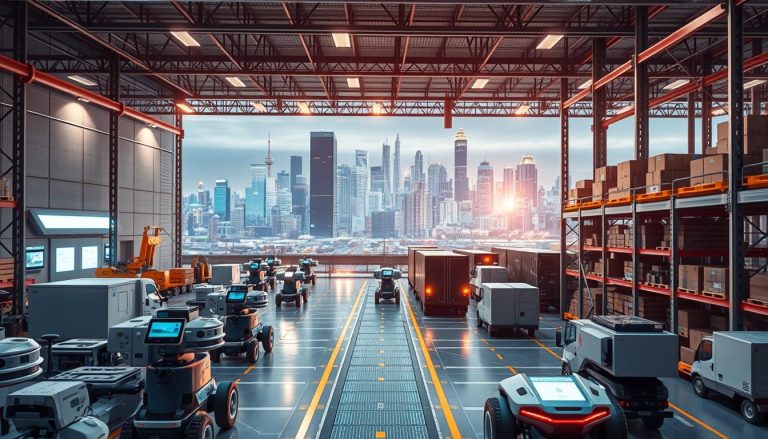Revolutionize Your Supply Chain with Technology
Supply chain leaders are now facing tighter cycles, volatile demand, and increased compliance pressure. The solution lies in a digital supply chain, powered by modern platforms and governed by data. KPMG’s 2024 analysis reveals a shift towards generative AI, machine learning, IoT, blockchain, low-code tools, and automation. These technologies are transitioning from pilot projects to standard practices in U.S. operations.
Adopters are experiencing quicker responses to daily requests, fewer errors, and enhanced traceability across complex networks. KPMG forecasts that by 2024, about 50% of supply chain organizations will invest in AI and advanced analytics. This marks a significant move towards performance-driven decisions and resilient models capable of handling shocks.
The focus now is on effective execution. It’s essential to create a secure, modular architecture, improve data quality, and enforce governance. This unlocks ROI and meets ESG and Scope 3 reporting requirements. With disciplined change, logistics technology becomes a powerful tool. It enhances visibility, speed, and control in planning, procurement, and last-mile operations within a scalable digital supply chain.
From Linear to Digital: How Logistics Technology Is Redefining Visibility and Speed
Supply chains are evolving from batch updates and manual checks to continuous telemetry and shared intelligence. Logistics technology is at the forefront, connecting carriers, manufacturers, and retailers through a digital supply chain. This system orchestrates orders, rates, and routes, aligning plans with real-time conditions through AI and cloud services.
Interconnected networks vs. traditional, reactive chains
Traditional chains rely on outdated averages and isolated tools, slowing cycle times and hiding risks. In contrast, interconnected networks use sensors, APIs, and standardized events to synchronize demand, inventory, and transport.
Companies like Amazon, Maersk, and UPS are leading the way with network design, dynamic slotting, and carrier collaboration. This approach gives planners lane-level visibility and enables faster exception handling across the digital supply chain.
Real-time data sharing through IoT and cloud platforms
IoT devices provide real-time data on location, temperature, and shock from pallets and trailers. Cloud platforms from Microsoft Azure and Google Cloud merge this data with orders, tariffs, and capacity signals. Blockchain ledgers add immutable status and custody events.
When a port delay occurs, the transportation management system recalculates ETA, reprioritizes loads, and triggers supplier alerts. This workflow reduces dwell, shortens lead times, and protects service levels in a volatile market.
User engagement: why transparency and responsiveness drive loyalty
Real-time milestones, proof of delivery, and exception alerts build trust with buyers and partners. Transparent updates cut inquiry volume and strengthen repeat business. Responsiveness turns disruptions into service moments that enhance brand value.
By aligning control towers, customer portals, and the transportation management system, organizations provide accurate ETAs and rapid resolution. This approach elevates satisfaction while supporting efficient operations across the digital supply chain.
| Capability | Traditional Linear Chain | Digital Networked Model | Operational Impact |
|---|---|---|---|
| Data Timeliness | Batch, end-of-day | Streaming via IoT and cloud | Faster detection of delays and risks |
| Visibility | Fragmented by siloed systems | Unified view across partners | Accurate ETAs and proactive planning |
| Decision Support | Manual, reactive | AI-assisted, predictive | Shorter cycle times and fewer expedites |
| Transaction Integrity | Email and paper-based | Blockchain-backed events | Trusted records and faster dispute resolution |
| Execution Control | Isolated TMS per site | Networked transportation management system | Optimized routing and carrier utilization |
| User Engagement | Periodic status checks | Transparent portals and alerts | Higher loyalty and reduced call volume |
Key Trends Powering the Digital Supply Chain in 2024
Enterprises are transforming their operations with a focus on data and strategic investments in supply chain technology. Analysts note a surge in AI tools, low-code solutions, eco-friendly fleets, and blockchain adoption. These advancements enhance agility and reduce costs, improving supply chain efficiency and risk management.
Generative AI, machine learning, and advanced analytics adoption
AI is transforming planning, procurement, and logistics, with nearly half of companies investing in new AI capabilities. Generative AI processes vast datasets, learns specific rules, and aids in compliance and virtual interactions. It boosts forecasting accuracy and efficiency, supporting digital supply chain advancements without increasing staff.
Low-code/no-code platforms accelerating automation
Low-code platforms streamline development with APIs and pre-built integrations from giants like Microsoft, ServiceNow, and Salesforce. Citizen developers automate tasks in planning, manufacturing, and collaboration. With over two-thirds of companies adopting these tools, teams can modernize processes swiftly, extending automation to older systems.
Fleet electrification and autonomous logistics expansion
Battery electric commercial vehicle sales are expected to hit 15%–34% by 2030. AI and IoT-driven telematics from Geotab and Samsara optimize routes and charging. Autonomous pilots are also growing, reducing downtime and emissions, and aligning with data-driven supply chain strategies.
Distributed ledger technologies for traceability and trust
Distributed ledgers create unalterable records and automate verification with smart contracts. Platforms like IBM Food Trust and VeChain track origins, cut fraud, and speed up recalls. As blockchain evolves, it fosters shared visibility and verifiable audit trails, enabling effective multi-tier collaboration and automation.
Generative AI in Operations: Smarter Planning, Procurement, and Execution
Generative AI is transforming core operations in the digital supply chain. It processes vast, complex datasets to bridge the gap between planning and execution. With modern logistics technology and targeted supply chain automation, it achieves faster cycle times and tighter control.
Self-learning models for anomaly detection and disruption response
Self-learning models quickly identify demand spikes, lead-time changes, and quality issues. They assess risk, pinpoint causes, and suggest actions like order reallocation or supplier changes. This enhances service quality while controlling premium freight costs.
Platforms from Amazon Web Services, Google Cloud, and Microsoft Azure support scalable data ingestion and model training. When combined with edge logistics technology—IoT sensors, telematics, and automated alerts—response plans can swiftly update workflows and inventory.
Virtual assistants for logistics communication and compliance support
GenAI copilots streamline procurement and production workflows, as KPMG analyses show. Virtual assistants manage status updates, carrier inquiries, and document preparation with consistent language and audit trails. They reduce email clutter and expedite handling of exceptions in international shipments.
Integrated in systems from SAP, Oracle, and Blue Yonder, assistants verify trade codes, generate packing lists, and capture delivery proof. This supports supply chain automation and enhances data quality for the digital supply chain.
Performance-led decision-making and data governance as success factors
Leaders define measurable targets, such as forecast accuracy and on-time delivery, to guide operations. Decision-making frameworks, escalation paths, and regular meetings anchor analytics to financial outcomes. This ensures initiatives remain aligned with broader goals.
Robust data governance—master data controls, lineage, and access policies—avoids model drift and bias. Companies blend domain expertise with data science, train planners in modeling, and build ecosystems with technology vendors and universities. This responsible scaling of logistics technology is essential.
| Operational Area | GenAI Capability | Primary Data Inputs | Measured Outcome | Tooling Examples |
|---|---|---|---|---|
| Demand & Supply Planning | Anomaly detection and scenario generation | POS data, orders, lead times, promotions | Lower forecast error; faster replans | Google Vertex AI; AWS SageMaker |
| Procurement Compliance | Policy checks and contract summarization | Contracts, RFQs, supplier scorecards | Reduced maverick spend; audit-ready records | SAP Ariba; Oracle Procurement |
| Logistics Execution | Virtual assistants and automated case routing | TMS events, EDI messages, telematics | Fewer exceptions; quicker resolution | Blue Yonder TMS; Oracle Transportation Management |
| Quality & Manufacturing | Defect pattern mining and corrective actions | SCADA, MES, IoT sensor feeds | Lower scrap; higher first-pass yield | Siemens Opcenter; Rockwell FactoryTalk |
| Customer Service | Proactive ETA updates and response drafting | WMS/TMS milestones, weather, port data | Higher fill rate; improved NPS | Salesforce Service Cloud; Microsoft Dynamics 365 |
AI-Enabled Low-Touch Planning for S&OP and IBP
Low-touch planning leverages advanced analytics to quickly identify anomalies and suggest immediate actions. It bridges supply chain technology with core planning processes, ensuring alignment between demand, supply, and finance. This integration enhances inventory management and warehouse operations, leading to better allocation and service levels.
Control towers and cognitive decision centers with digital twins
Modern control towers and cognitive centers employ digital twins to replicate plants, warehouses, and lanes. These digital models simulate scenarios before they are executed, aligning plans with operations seamlessly. When combined with inventory management software, they optimize stock placement by node. The warehouse management system then orchestrates tasks to meet these targets.
Vendors like SAP, Oracle, and Blue Yonder link these digital twins to real-time signals from IoT and ERP systems. This integration streamlines the process from detection to response, fostering traceable decision-making.
Freeing teams to focus on value-add work and scenario analysis
Automation eliminates the need for manual data preparation, reconciliations, and status checks. This frees planners to focus on scenario modeling, risk management, and cross-functional trade-offs. Inventory management software handles policy updates, while the warehouse management system drives slotting and wave planning. This allows teams to concentrate on supplier negotiations and service recovery.
Structured workflows ensure clear decision-making and a consistent rhythm. Finance, sales, and operations collaborate, using shared assumptions and auditable metrics to evaluate options.
Expected impact on predictability, ROE, and gross margins
KPMG studies indicate that low-touch planning can significantly enhance predictability and Return on Equity. It can increase ROE by 2–4 percentage points and gross margins by 1–3%. These improvements stem from more accurate forecasts, leaner working capital, and reduced expediting costs. The strategic use of supply chain technology, inventory management software, and warehouse management systems supports these gains.
Success hinges on performance-driven governance, continuous data quality improvement, and upskilling of planners. Digital twins bridge the gap between planning and execution, enabling swift responses to disruptions and precise inventory placement across nodes.
| Capability | Primary Function | Operational Effect | Financial Lever | Representative Providers |
|---|---|---|---|---|
| Control Tower | End-to-end visibility and exception management | Faster alerts, coordinated response | Reduced premium freight and stockouts | SAP, Oracle, Kinaxis |
| Digital Twin | Virtual model for scenario testing | Optimized flow and capacity alignment | Higher throughput, lower inventory | Siemens, Dassault Systèmes, PTC |
| Inventory Management Software | Policy setting, safety stock, reorder logic | Precise positioning by node | Working capital efficiency | ToolsGroup, Blue Yonder, SAP IBP |
| Warehouse Management System | Execution of receiving, picking, and slotting | Higher pick accuracy and labor productivity | Lower fulfillment cost | Manhattan Associates, Oracle WMS, Körber |
| Advanced Analytics | Anomaly detection and prescriptive actions | Near-instant recommendations | Margin protection and service stability | Google Cloud, Microsoft Azure, AWS |
The Critical Role of Data: Quality, Cadence, and Consistency
Every part of the digital supply chain now sends out data from sensors, scanners, and platforms. This data’s value grows when it’s available, of high quality, and consistent. KPMG suggests that these elements are key to making informed decisions and maintaining resilience in areas like procurement, logistics, and customer service.
Data silos and duplication can harm planning accuracy and network optimization. A focused approach aims to fix the most critical issues first. This includes aligning SKU, location, and event timestamps across different systems. Such efforts lead to reduced waste, improved forecast accuracy, and enhanced service levels.
It’s vital to align data improvements with business goals. Roadmaps should outline how data enhancements lead to cost savings, efficiency boosts, customer satisfaction, and innovation. Good governance and stewardship keep rules up-to-date, while standardized data collection ensures comparability. These steps enable predictive analytics, control towers, and digital twins to grow across the digital supply chain.
High-quality data also fuels AI, automation, and ESG reporting. When master and event data are in sync, detecting exceptions becomes better, cycle times shorten, and carbon metrics can be audited. Integrated systems provide the necessary framework for data ingestion, validation, and lineage tracking that leaders need.
Clear operating models are essential for enterprise adoption. Data owners, stewards, and analytics teams must define roles, SLAs, and escalation procedures. Continuous improvement—such as schema checks, anomaly flags, and cadence reviews—ensures data reliability and actionability within the digital supply chain.
Beyond Tier 1 and 2: Achieving Deep Transparency and Traceability
Limited visibility beyond direct suppliers hampers risk management and compliance. KPMG reveals that 43% of companies lack visibility even at tier 1. This indicates significant blind spots further down the supply chain. A digital supply chain, backed by advanced technology, extends visibility across tiers and regions.

Mapping sub-tier suppliers to surface hidden risks
Systematic mapping uncovers common sub-tier suppliers, shared factory sites, and material dependencies. It identifies concentration risks, labor noncompliance, and component single points of failure. By integrating ERP and procurement data with trade records, a clear view is achieved, strengthening the digital supply chain.
For verification, blockchain in supply chain programs record events that cannot be altered. This creates an immutable trail, improving audit readiness and building trust with regulators and customers.
Using digital twins to visualize multi-tier flows
Digital twins combine orders, lead times, capacity, and logistics constraints into a live model. Control towers monitor these flows, revealing bottlenecks and testing scenarios for rerouting or dual sourcing. This transforms static reports into real-time intelligence, powered by supply chain technology.
With this insight, planners can assess time-to-recover, simulate port closures, and adjust safety stock by node and lane. Visualization aids in quicker decision-making during shortages or policy changes.
Embedding ESG metrics into supplier scorecards
Procurement teams include ESG indicators—such as emissions intensity, renewable energy share, and audit outcomes—in scorecards. Weighted metrics align sourcing with sustainability goals and contractual obligations. This approach fits a digital supply chain that views compliance, cost, and service as interconnected outcomes.
Data-sharing agreements and cross-functional governance extend the framework into sub-tiers. Blockchain in supply chain tools capture chain-of-custody events, improving traceability across regions and product lines.
| Capability | Primary Objective | Data Sources | Key KPI | Enabling Tools |
|---|---|---|---|---|
| Sub-tier Mapping | Expose concentration and compliance risks | ERP, purchase orders, customs filings | Nodes with single-source exposure (%) | Network graph analytics, supply chain technology |
| Digital Twin Visualization | Model multi-tier material and info flows | IoT telemetry, lead times, capacity plans | Time-to-recover by node (days) | Control towers, simulation engines |
| ESG Scorecard Integration | Align sourcing with sustainability goals | Audit results, emissions factors, energy data | Suppliers meeting ESG thresholds (%) | Scorecard platforms, digital supply chain dashboards |
| Immutable Traceability | Prove provenance across tiers | Chain-of-custody events, batch IDs, GPS | Provenance verification rate (%) | Blockchain in supply chain, smart contracts |
Low-Code Platforms: Accelerating Supply Chain Automation
Low-code platforms significantly reduce deployment time across complex networks. These networks span ERP, a warehouse management system, TMS, and partner portals. By combining visual design with governed components, teams can scale supply chain automation. This is done while maintaining controls required by finance, quality, and IT risk.
Connecting legacy systems with APIs and prebuilt integrations
Prebuilt connectors link various systems, including SAP, Oracle, Microsoft Dynamics, and Manhattan to carrier systems and IoT feeds. These integrations standardize events and master data, improving handoffs between logistics technology and a warehouse management system. KPMG reports that over two-thirds of enterprises have adopted low-code in their supply chains. They cite faster cycle times and fewer interface errors as benefits.
Citizen development for rapid workflow digitization
Business users design order holds, supplier collaboration steps, and returns routing with drag-and-drop logic. Guardrails enforce data policies, while IT governs versioning and APIs. This approach speeds supply chain automation when tariffs change, capacity shifts, or service levels need updates across logistics technology stacks.
Use cases in planning, collaboration, and track-and-trace
- Planning: digitize approvals, scenario routing, and exceptions tied to forecast changes.
- Collaboration: automate vendor onboarding, scorecards, and ASN validation in a warehouse management system.
- Track-and-trace: connect telematics, yard status, and carrier EDI to real-time milestones and alerts.
- Visibility: build dashboards that unify orders, inventory, and transport events for control tower teams.
| Capability | Operational Outcome | Primary Systems Touched | Example Metrics |
|---|---|---|---|
| API connectors and adapters | Faster interface deployment and fewer data errors | ERP, warehouse management system, TMS | Integration lead time: −40%; error rate: −60% |
| Citizen-built workflows | Quicker policy and process changes | Supplier portals, quality apps, logistics technology | Change cycle time: −50%; compliance steps automated: +30% |
| Track-and-trace apps | Unified shipment events and proactive alerts | Telematics, EDI, control tower | On-time delivery variance: −20%; manual checks: −70% |
| Visibility dashboards | Single view of inventory, orders, and transport | ERP, WMS, TMS, partner APIs | Expedites: −25%; planner productivity: +15% |
ESG and Scope 3 Emissions: Data, Platforms, and Supplier Engagement
Scope 3 emissions are now a key focus for companies aiming to reduce their carbon footprint. Supply chain emissions often exceed those from direct operations by 5–10 times. Yet, only a small fraction comes from on-site manufacturing. The use of digital supply chain technology is essential for capturing, verifying, and reporting emissions at scale.
Building baselines and hybrid accounting methodologies
Creating reliable baselines requires primary data from suppliers, not just industry averages. A hybrid method combining activity data with emission factors enhances accuracy over time. KPMG suggests segmenting suppliers by spend and criticality to maximize impact.
Companies must document assumptions and version models to keep up with audits. Smart contracts and blockchain in supply chain workflows provide tamper-evident logs. This improves assurance throughout the reporting cycle.
Digital platforms to capture primary supplier emissions
Centralized platforms standardize data intake and apply factors automatically. They integrate with ERP, PLM, and sustainability systems for consistent Scope 3 reporting. This approach is ideal for a digital supply chain needing fast updates and consistent governance.
Supply chain technology supports machine-assisted checks and supplier scorecards. It also sends alerts for outliers. Distributed ledgers record verification steps, while APIs pull data from partners for near-real-time accuracy.
Change management and education across your value chain
Engaging suppliers requires clear guidelines, templates, and training. Internal teams need to understand Scope 3 concepts and how to interpret data quality flags and confidence levels.
KPMG advises launching education waves by category, pairing it with incentives and feedback. Over time, supplier capabilities improve, and the digital supply chain gains traceable evidence supported by technology and blockchain records.
| Focus Area | Primary Objective | Practical Actions | Value to Scope 3 Program |
|---|---|---|---|
| Baseline Quality | Elevate accuracy beyond averages | Collect primary activity data; apply hybrid accounting; document emission factors | Higher precision in category totals and year-over-year comparisons |
| Supplier Segmentation | Prioritize high-impact partners | Rank by spend, criticality, and emissions intensity as advised by KPMG | Faster data coverage with measurable improvements |
| Platform Integration | Streamline intake and reporting | Connect ERP/PLM to sustainability software; automate unit mapping and factor updates | Lower manual effort and fewer reconciliation errors |
| Assurance & Auditability | Strengthen evidence trails | Use smart contracts and blockchain in supply chain for immutable logs | Improved confidence for internal audit and external assurance |
| Change Management | Build durable capabilities | Train staff and suppliers; publish playbooks; run phased adoption waves | Consistent data cadence and higher supplier participation |
| Performance Uplift | Turn data into action | Embed scorecards, alerts, and reduction pathways in digital workflows | Faster identification of hot spots and verifiable reductions |
Electric and Autonomous Logistics: The Next Wave in Transportation Management
U.S. shippers are now focusing on electrification and autonomy to meet cost and emissions targets. KPMG forecasts that battery electric commercial vehicles could make up 15%–34% of sales by 2030. A transportation management system is at the core of planning, managing fleets, chargers, and routes under one system.
Fleet assessments to prioritize electrification and routes
Effective programs begin with understanding the fleet’s composition, exposure to urban areas, and duty cycles. Teams assess stop density, average daily miles, and depot dwell time to pinpoint cost-effective opportunities.
Routes with high frequency in urban areas, where charging is reliable, are prioritized. A transportation management system optimizes vehicle assignment, charger use, and shift planning. This approach minimizes range risks and overtime.
AI- and IoT-driven telematics for network optimization
AI and IoT sensors provide real-time data on vehicle state, temperature, and load to logistics platforms. Algorithms adjust charging schedules, consolidate stops, and rebalance loads to reduce empty miles and energy costs.
Cloud models simulate route and charging scenarios before dispatch. This supports supply chain automation by integrating predictive maintenance with dynamic routing during peak demand.
Automation opportunities from warehouse to last mile
Automation is expanding from port yards and high-bay warehouses to neighborhood delivery zones. Autonomous systems are venturing beyond controlled loops, supported by geofencing, V2X signals, and safety monitors.
Orchestration improves when robotics, depot chargers, and the transportation management system share a common data layer. This leads to more efficient dock scheduling, faster cross-docking, and supply chain automation. It maintains service levels while significantly reducing tailpipe emissions.
Supply Chain Technology
Enterprise supply chains are evolving towards integrated, data-centric architectures. Companies now link planning, execution, and finance through unified platforms. These platforms standardize data and enforce governance, leading to faster cycles, higher accuracy, and better asset utilization.
Inventory management software, WMS, and TMS integration
By integrating inventory management software with warehouse and transportation management systems, a seamless flow from order capture to delivery is achieved. Real-time updates ensure stock levels, pick waves, dock schedules, and carrier tenders are in sync.
This integration minimizes manual errors and enhances order cycle efficiency. Companies experience tighter inventory accuracy and higher trailer fill rates. This is due to the streamlined flow of information within a single system of record.
Blockchain in supply chain for fraud reduction and provenance
Distributed ledgers maintain immutable records of custody and transactions. Smart contracts automate key processes, reducing disputes and counterfeit risks.
Brands in food, pharmaceuticals, and luxury goods leverage blockchain for on-chain provenance. This verifies lot lineage and temperature data, improving recall precision and audit readiness.
Designing a resilient, data-driven digital supply chain
Resilience is built on clean, consistent data and performance-driven decision-making. Control towers, digital twins, and low-code tools align operations around shared metrics and rapid iteration.
KPMG’s 2024 guidance emphasizes ecosystem design, strong data stewardship, and analytical modeling skills. Companies that align platform choices with measurable outcomes—predictability, ROE uplift, and gross margin gains—gain a lasting competitive edge.
- Key enablers: inventory management software for accurate stock positions, a warehouse management system for orchestrated fulfillment, and a transportation management system for optimized routing and carrier mix.
- Operational levers: real-time data exchange, smart workflows, and exception-driven control to maintain service levels during volatility.
Conclusion
The 2024 playbook emphasizes targeted AI and GenAI, along with low-touch planning and disciplined data governance. KPMG highlights AI’s broad momentum and tangible benefits from low-touch planning. These include enhanced predictability, a 2–4 percentage point increase in ROE, and a 1–3% gross margin boost. Distributed ledgers enhance traceability and fraud reduction, while AI and IoT in telematics optimize routes and asset utilization. These elements are key to a high-performing digital supply chain.
Progress also hinges on deep visibility, practical low-code deployment, and ESG with Scope 3 data platforms. Mapping sub-tiers uncovers hidden constraints and compliance risks. Low-code solutions expedite workflow digitization and bridge legacy systems for quicker cycles. Scope 3 platforms standardize emissions reporting, meeting investor and regulatory expectations. These capabilities bolster supply chain technology, enabling consistent execution.
Leaders should focus on a performance-led roadmap, improve data quality, and upskill teams. Building robust partner ecosystems with Microsoft, Amazon Web Services, and SAP is essential. Begin with clear value cases in planning, procurement, and logistics, then scale. This strategy propels supply chain automation and fosters resilient, cost-effective operations throughout the network.
Organizations that act promptly can unlock value through superior service levels, lower working capital, and reduced emissions. The result is a digitally orchestrated operation. It combines analytics, automation, and governance for speed, trust, and control. This is how supply chain technology translates strategy into measurable outcomes in the modern digital supply chain.
FAQ
How does logistics technology shift supply chains from linear to digital models?
Digital supply chains link partners through cloud platforms, IoT telemetry, and AI analytics. This enables real-time visibility and predictive decision-making. It replaces outdated, siloed reporting with synchronized planning and quicker disruption response.
The outcome is shorter cycle times, better delivery reliability, and higher service levels across multi-tier networks.
What are the priority technology investments in 2024 for visibility, speed, and resilience?
KPMG’s 2024 analysis highlights strong investment in generative AI, machine learning, IoT, and blockchain in supply chains. Low-code platforms also see significant investment. Half of supply chain organizations are funding AI and advanced analytics for performance-led decisions.
Low-code platforms accelerate integration across various systems, including ERP, WMS, TMS, and inventory management software.
Where does generative AI deliver the fastest ROI in operations?
Generative AI shows the fastest ROI in S&OP/IBP forecasting, anomaly detection, procurement compliance, and virtual assistants. It handles routine logistics inquiries. Self-learning models bridge the gap between planning and execution by identifying risks and suggesting corrective actions.
This improves predictability and reduces manual rework.
How do control towers and digital twins improve planning accuracy?
Control towers aggregate real-time data from various systems. Digital twins simulate the network to test scenarios. Together, they enhance inventory positioning and cut response times to disruptions.
They support low-touch planning with near-instant recommendations for planners.
What financial impact can low-touch planning have on performance metrics?
KPMG reports that low-touch planning can increase Return on Equity by 2–4 percentage points. It can also expand gross margins by 1–3%. These gains come from better forecast accuracy, optimized inventory, and faster execution.
Reduced exceptions free teams to focus on higher-value analysis.
Why is data quality and governance essential for a digital supply chain?
High-quality, consistent data is vital for AI models, automation, and ESG reporting. Prioritizing data availability, cadence, reliability, and consistency eliminates silos and misinterpretation. A roadmap targets improvements where value is highest.
It ensures reliable control towers, predictive analytics, and accurate Scope 3 disclosures.
How can companies extend visibility beyond tier 1 suppliers?
Multi-tier mapping, data-sharing agreements, and digital twins reveal sub-tier relationships and common suppliers. Embedding ESG metrics in supplier scorecards and using distributed ledger technologies for immutable provenance records strengthen compliance and risk management.
What role do low-code platforms play in supply chain automation?
Low-code platforms connect legacy stacks via APIs and prebuilt integrations. They enable rapid workflow digitization by business users. Common use cases include order orchestration, vendor onboarding, returns management, and track-and-trace dashboards.
These dashboards integrate telematics and partner data for end-to-end visibility.
How should organizations approach Scope 3 emissions measurement and reporting?
Establish baselines with primary supplier data and augment with hybrid accounting. Centralize collection on digital platforms integrated with reporting tools. Segment suppliers by spend and criticality, launch engagement programs, and use smart contracts on distributed ledgers.
What are the near-term steps to electrify and automate logistics networks?
Conduct fleet assessments to identify routes suitable for battery electric vehicles. Deploy AI- and IoT-enabled telematics for route optimization, charging schedules, and load balancing. Scale automation from warehouses to last mile using cloud-based AI.
Simulate network designs and sustainability outcomes.
How do WMS, TMS, and inventory management software integration improve performance?
Integrated stacks synchronize planning, fulfillment, and transportation. They enable real-time data exchange on orders, inventory, and carrier capacity. This improves inventory accuracy, reduces order cycle times, lifts asset utilization, and enhances customer communication.
When does blockchain in supply chain deliver measurable value?
Distributed ledgers provide immutable transaction and custody records. They reduce fraud, strengthen provenance, and automate workflows via smart contracts. They are most effective for high-risk, multi-tier environments requiring traceability.
What governance practices sustain ROI from AI and automation?
Performance-led decision disciplines, rigorous data governance, and clear KPIs align technology with measurable outcomes. Organizations should redesign core processes, upskill planners in analytical modeling, and build partner ecosystems. This scales solutions without fragmentation.







